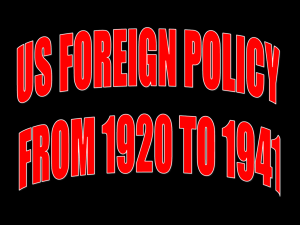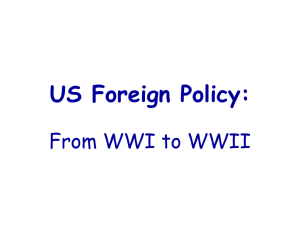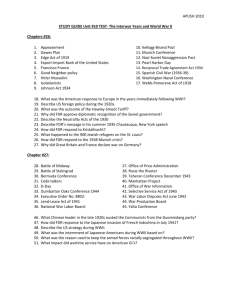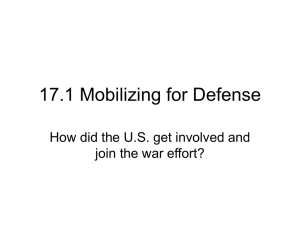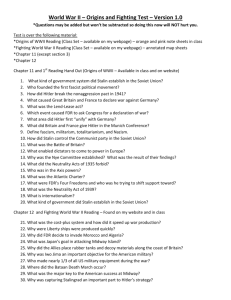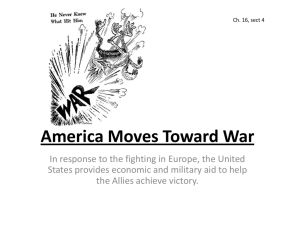US becomes the arsenal of democracy
advertisement
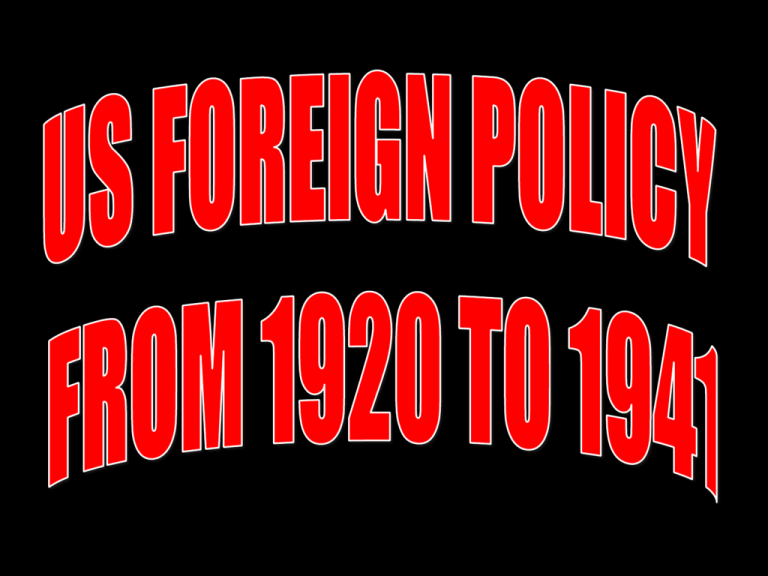
Foreign Policy Tensions Interventionism • Collective security • “Wilsonianism” • Business interests Disarmament • Isolationism • Nativists • Anti-War movement • Conservative Republicans American Isolationism 5 Isolationists like Senator Lodge, refused to allow the US to sign the Versailles Treaty. 5 Security treaty with France also rejected by the Senate. 5 July, 1921 Congress passed a resolution declaring WW I officially over! Sen. Henry Cabot Lodge, Sr. [R-MA] Problems in Europe After WWI Great Depression •Economic = people were jobless •Political = weak governments could not solve problems in their countries. Fear of Jews and Communists •Social = times of unrest people look for a leader. •Power of government rests in one man. •TOTAL POWER •No freedoms in this society….. •Usually racist and discriminatory towards certain groups…… •Often have large militaries and must expand and conquer to gain approval from their people. dictators dictators Benito Mussolini 1922/Italy---Facism Believe, Obey and Fight Revive the Roman Empire FACISM: BASED ON A SYMBOL OF AUTHORITY IN THE OLD ROMAN EMPIRE…………”a philosophy or system of government that advocates or exercises a dictatorship, state control of industry, racial superiority, supremacy of the leader, limits civil rights, together with an ideology of belligerent nationalism, militarism and expansion…..” •Joseph Stalin •1921/Soviet Union Communism Spread Communism throughout the world •Stalin maneuvered himself into becoming the leader of the Soviet Union. •The Russian Revolution was led by the people to overthrow a monarch but when the new ruling class took over, there were no protections of people’s rights…… “NO BILL OF RIGHTS” •Communism and fascism are similar in their ideologies dictators Took the form of a god and ruled Japan from 1926 to 1989. Japan’s Manifest Destiny was to expand into China and the rest of Asia. Empire of the Sun Emperor Horhito dictators 1931/Japan, expansionist and military leader •Would threaten our island possessions and U.S. trade policy into China, Open Door Policy. •Planned the Pearl Habor attack Hideki Tojo dictators Adolph Hitler, fought in WWI and hated the Treaty of Versailles 1920s, became involved with the NAZI party which wanted to restore German pride. Became dictator of Germany in 1933. Create a new empire, “Third Reich” •Revenge towards the Treaty of Versailles Rearm Germany Take back land lost from WWI dictators Four-Power Pact (December 13, 1921). Britain, France, Japan and the United States agreed to submit disputes among themselves over Pacific issues to a conference for resolution. Pledged mutual respect for the possessions and mandates of other signatories (participants) in the Pacific. Five-Power Naval Limitation Treaty (February 6, 1922). The leading naval powers, Britain, France, Italy, Japan and the United States pledged adherence to limitations on the tonnage of capital ships and accepted a moratorium on new naval construction. 5-3-1 ration Britain could only have 1 ship for every 3 ships in Japan, and Japan could only have 3 ships for every 5 ships in the U.S. Britain, U.S. and Japan agreed to dismantle some existing vessels to meet the ratio. Five-Power Naval Limitation Treaty (February 6, 1922). Agreed on a series of rules for the use of submarines in future warfare and also outlawed the use of poisonous gases as a military weapon. Nine-Power Treaty (February 6, 1922). Big Four, plus Italy, Belgium, the Netherlands, Portugal and China endorsed the Open Door Policy and pledged mutual respect for Chinese territorial integrity and independence. In the following months, the U.S. Senate ratified all of the treaties from the Washington Conference. The Kellogg-Briand Pact provided for outlawing war as an “an instrument of national policy,” and was further notable for the following: The pact was signed in August 1928 by 15 nations. In the following months, more than 60 countries joined in this renunciation of war. The U.S. Senate Foreign Relations Committee studied the matter and issued a report that maintained that the pact did not impair the nation’s ability to act to protect the Monroe Doctrine. US Senate ratified this treaty. Afghanistan Finland Peru Albania Guatemala Portugal Austria Hungary Rumania Bulgaria Iceland Russia China Latvia Kingdom of the Serbs Cuba Liberia Croats and Slovenes Denmark Lithuania Siam Dominican Republic Netherlands Spain Egypt Nicaragua Sweden Estonia Norway Turkey Ethiopia Panama Additional countries which join by July 24, 1929. Persia, July 2, 1929; Greece, August 3, 1929; Honduras, August 6, 1929; Chile, August 12, 1929; Luxemburg August 14, 1929; Danzig, September 11, 1929; Costa Rica, October 1, 1929; Venezuela, October 24, 1929. The Kellogg-Briand Pact provided for outlawing war as an “an instrument of national policy,” and was further notable for the following: Major problems with this treaty 1. No enforcement mechanism was provided for changing the behavior of warring signatories. 2. The agreement was interpreted by most of the signatories to permit “defensive” war. 3. No expiration date was provided. 4. No provision existed for amending the agreement was included. In the 1930’s, the idealism of “ending all war” would be shattered when the Japanese, Italy, Germany and Soviet Union began WWII. Idealism, is what it is: “ideas”. Some can work and others can’t. In a realistic world, countries realized that they needed to protect themselves from aggressor nations. It is still this way today but we have the United Nations to promote world peace and “contain” aggressor nations. Dawes Plan •Presented in 1924 by the committee headed by Charles G. Dawes to the Reparations Commission of the Allied nations. It was accepted the same year by Germany and the Allied Nations. •The Dawes Committee was entrusted with finding a solution for the collection of the German reparations debt, set at almost $54 billion. •Germany had been lagging in payment of this obligation and the Dawes Plan provided a repayment schedule over 4 years to the Allies. The Germans would continue to lag behind in payments. Dawes Plan (1924) Clark Memorandum (1928) Clark pledged that the US would not intervene in Latin American affairs in order to protect US property rights. This was a complete Secretary of State J. Reuben Clark rebuke of the Roosevelt Corollary to the Monroe Doctrine! FDR’s “Good Neighbor” Policy Important to have all nations in the Western Hemisphere united in lieu of foreign aggressions. FDR The good neighbor respects himself and the rights of others. Policy of non- intervention and cooperation. •BETWEEN 1931 TO 1941, JAPAN INVADES MOST OF ASIA AND WAS THREATENING U.S. ISLANDS AND OUR OPEN DOOR TRADE POLICY. •FROM 1935 TO 1939, HITLER REMARMED GERMANY IN VIOLATION OF THE TREATY OF VERSAILLES. •GERMANY/ITALY CONQUERED ALL THE DEMOCRACIES IN EUROPE. •US POLICY WAS STRICT NEUTRALITY BUT ULTIMATELY WOULD BE DRAWN INTO WWII. democracies Hoover-Stimpson Doctrine (1932) US would not recognize any territorial acquisitions that were achieved by force. Japan was infuriated because the US had conquered new territories a few decades earlier. Japan bombed Shanghai in 1932 massive casualties. FDR Recognizes the Soviet Union (late 1933) FDR felt that recognizing Moscow might bolster the US against Japan. Maybe trade with the USSR would help the US economy during the Depression. Ludlow Amendment (1938) A proposed amendment to the Constitution that called for a national referendum on any declaration of war by Congress. Introduced several Congressman Louis Ludlow [D-IN] times by Congressman Ludlow. Never actually passed. •1935: prohibited arms shipments to all belligerent countries. •1936: forbid loans to all belligerents •1939: prohibited Americans from traveling on ships of belligerent nations •FDR responds to Fascist aggression in Europe by protecting democracies and preparing the US for war…..BUT TRYING TO Neutral REMAIN ISOLATED AND NEUTRAL 1939 Cash – Carry Program Any nation can buy from US as long as they pay cash and Carry it back to Europe 1940 Destroyer for Bases deal Brits need submarine hunters, US has a bunch of old destroyers in dry dock. •US trades the Brits the ships for leases and bases in the Caribbean •FDR talking neutrality but prepares for war •Americans wanted to remain neutral. •America First Committee •Committee to Defend America by Aiding the Allies •Feb. 21, 1940: If Germany is defeating England & France, should the U.S. declare war on Germany and send our Army and Navy to Europe to fight against Hitler? Yes: 23% Neutral No 77% FIRST, freedom of speech and expression, everywhere in the world. SECOND, freedom of every person to worship God in his own way,everywhere in the world. THIRD, freedom from want, which translated into world terms, economic and healthy peace time life, everywhere in the world. FOURTH, freedom from fear, worldwide reduction of armaments, everywhere in the world. Other things FDR stated: •The world order is to seek cooperation of free countries, in a friendly civilized society. •FDR’s speech to Congress in Jan. 1941 describing the threat of the Axis Powers. •FDR believed American security was seriously threatened and believed the struggle was over American democracy. •Freedom means the supremacy of human rights everywhere. atlantic1 LEND LEASE •RENTING, LEASING, GIVING BRITAIN AND LATER SOVIET UNION AND CHINA, MILITARY WEAPONS TO ARM THEM AGAINST THE GERMANS AND JAPANESE… •FDR’s FINAL ATTEMPT TO REMAIN NEUTRAL! •USA BECOMES THE “ARSENAL OF DEMOCRACY” U. S. Lend-Lease Act, 1941, “ US becomes the arsenal of democracy” Great Britain.........................$31 billion Soviet Union...........................$11 billion France......................................$ 3 billion China.......................................$1.5 billion Other European.................$500 million South America...................$400 million The amount totaled: $48,601,365,000 lend lease US offered Lend Lease as a last defense to stay out of war. It was given to Britain during the Battle of Britain in 1940, the Soviet Union after Hitler’s invasion in 1941 and China. The US became the “arsenal of democracy”. atlantic1 •FDR and Winston Churchill meet on the USS Augusta in the North Atlantic to sign the Atlantic Charter, August 12, 1941. •They met together to make known certain common principles of their respective countries on which they base their hopes for a better future for the world. atlantic1 FIRST, we seek not conquest of land or territory….. SECOND, no territorial changes of land between nations. THIRD, Restoration of sovereign rights and self-government FOURTH, Access to raw materials for all FIFTH, World economic cooperation SIXTH, Freedom from fear and want SEVENTH, freedom of the seas EIGHTH, Disarmament of aggressors NINTH, a United Nations for world peace. • Admiral Isoroku Yamamoto • Commander of the Japanese Navy • Responsible for the success of the Japanese attack of Pearl Harbor. • Captain Mitsuo Fuchida • Led the attack at Pearl Harbor. • “Tora, Tora, Tora” • “Attack, Attack, Attack” WWII Military Leaders In less than 2 hours, the Pacific Fleet lost two battleships, six others were heavily battered and nearly a dozen lesser vessels put out of action. More than 150 planes were wrecked; over 2,300 servicemen were killed and 1,100 wounded. Blame was widespread, both on the Officials in Washington and on the Admiral and the General in Hawaii. •After FDR’s Day of Infamy speech asking for a declaration of war against Japan, Congress approved the declaration…. •FDR signed the declaration of war against Japan on Dec. 8, 1941
